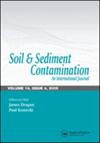Cr(vi) soil analytical method: A reliable analytical method for extracting and quantifying Cr(vi) in soils
IF 1.5
4区 环境科学与生态学
Q4 ENVIRONMENTAL SCIENCES
引用次数: 21
Abstract
Chromium has been used in the industrialized world in many applications for more than a century. Chromium is a trace metallic element found in the Earth's crust, and when it is found in concentrated ore deposits it is principally as FeCr2O4 (chromite ore). In the environment, chromium is typically found in the trivalent and hexavalent states. These two oxidation states have differing toxicities and mobilities. Hexavalent chromium [Cr(VI)] is classified as a known human carcinogen (via inhalation) and is rather mobile, whereas trivalent chromium [Cr(III)] is comparatively benign (it is an essential dietary element for humans) and relatively immobile. This significant toxicological and geochemical disparity between the two valence states necessitates that environmental investigators be able to quantitatively distinguish between these two forms in solid environmental media. Several regulatory‐approved analytical techniques exist for the quantitative differentiation between Cr(VI) and Cr(III) in aqueous solut...Cr(vi)土壤分析方法:一种可靠的土壤中Cr(vi)提取和定量的分析方法
一个多世纪以来,铬在工业化世界的许多应用中都得到了应用。铬是地壳中发现的一种微量金属元素,当它在浓缩矿床中被发现时,它主要是以FeCr2O4(铬铁矿)的形式存在。在环境中,铬通常以三价和六价状态存在。这两种氧化态具有不同的毒性和迁移率。六价铬[Cr(VI)]被列为一种已知的人类致癌物(通过吸入),并且具有相当大的流动性,而三价铬[Cr(III)]相对良性(它是人类必需的膳食元素),并且相对不具有流动性。这两种价态之间的显著毒理学和地球化学差异要求环境调查人员能够在固体环境介质中定量区分这两种形式。几种监管批准的分析技术存在于定量区分Cr(VI)和Cr(III)在水溶液中…
本文章由计算机程序翻译,如有差异,请以英文原文为准。
求助全文
约1分钟内获得全文
求助全文
来源期刊

Soil & Sediment Contamination
环境科学-环境科学
CiteScore
4.20
自引率
10.00%
发文量
53
审稿时长
2.2 months
期刊介绍:
When it comes to assessing and mitigating contaminated soils and sediments, there is no substitute for having the very latest tools, techniques and methodologies at your fingertips to help you deal with these issues efficiently and cost-effectively.
This is just the kind of essential expertise you’ll only find in Soil and Sediment Contamination . This internationally, peer-reviewed publication focuses on soil and sediment contamination from:
-Sludges-
Petroleum-
Petrochemicals-
Chlorinated hydrocarbons-
Pesticides-
Lead and other heavy metals.
Get detailed descriptions of all the latest and most efficient offsite and in situ remediation techniques, strategies for assessing health effects and hazards, and tips for dealing with everyday regulatory and legal issues. With the state-of-the-art tools that Soil and Sediment Contamination provides, you can successfully assess, mitigate, and solve both rural and urban soil contamination problems as efficiently and economically as possible.
 求助内容:
求助内容: 应助结果提醒方式:
应助结果提醒方式:


